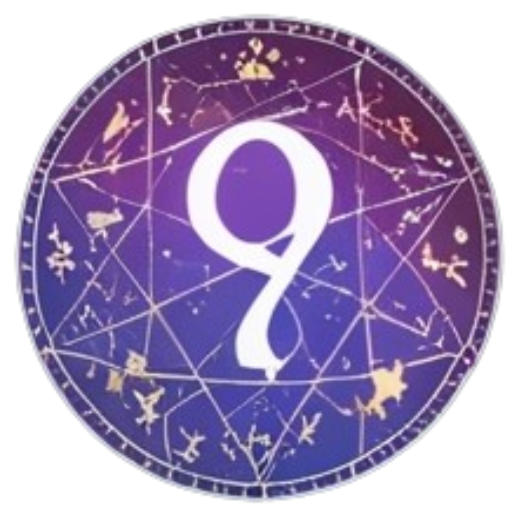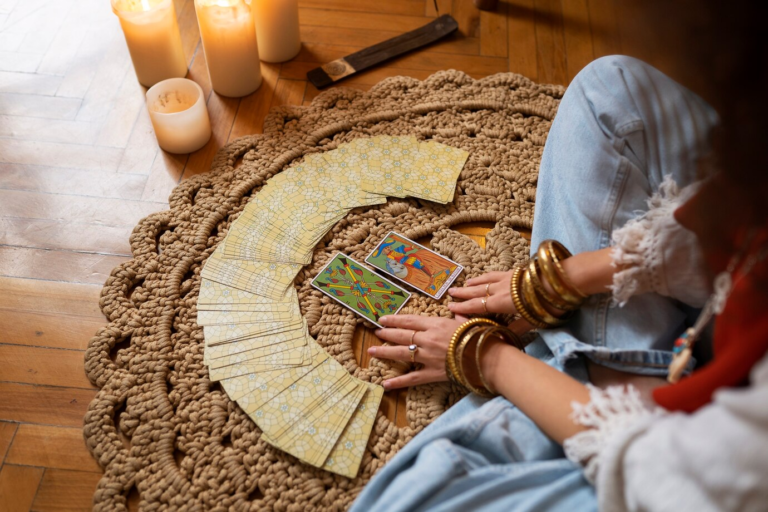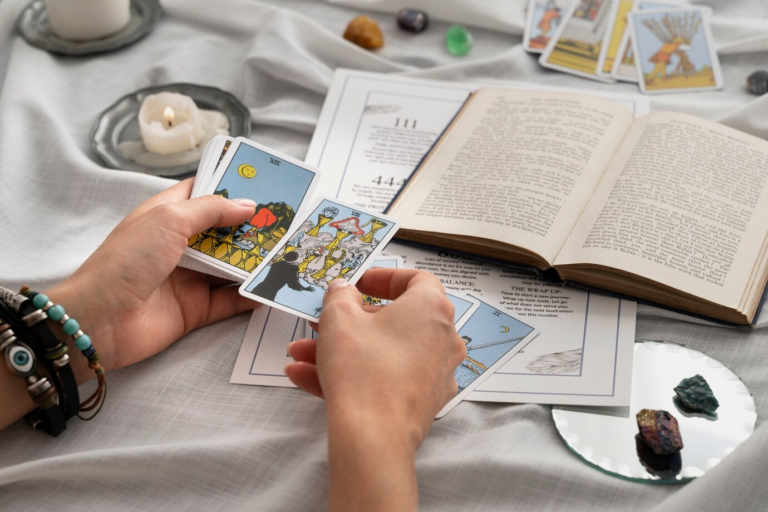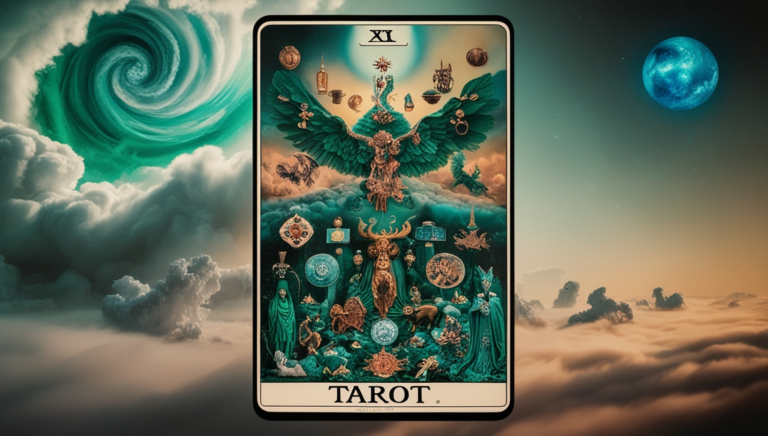
Reading tarot cards can feel like a mysterious and intimidating practice for beginners, but with a bit of knowledge and intuition, anyone can learn to read tarot effectively. Tarot readings offer insight, guidance, and a deeper connection with your subconscious or spiritual energy. In this guide, we’ll walk you through everything you need to know to start reading tarot cards, from preparing your deck to interpreting the cards themselves.
Guide for How to Read Tarot Cards
1. Understanding the Tarot Deck: The Basics
Before you start reading tarot cards, it’s essential to understand the deck. A standard tarot deck consists of 78 cards, divided into two main sections:
- The Major Arcana (22 cards): These cards represent significant life themes and major events. They include well-known cards like The Fool, The Magician, The Lovers, and Death. The Major Arcana deals with large, overarching lessons and spiritual truths.
- The Minor Arcana (56 cards): These cards represent everyday experiences, challenges, and influences. They are divided into four suits: Cups, Wands, Swords, and Pentacles, each focusing on different aspects of life (emotions, actions, intellect, and material aspects). The Minor Arcana cards are similar to a regular deck of playing cards, with numbers 1–10, a Page, Knight, Queen, and King in each suit.
By familiarizing yourself with the overall structure of the tarot deck, you can better understand the flow of a reading and the connections between the cards.
2. Preparing to Read Tarot Cards
Before diving into a reading, it’s important to set the right environment and intention. Here’s how to prepare:
Create a Sacred Space
Choose a quiet, calm space free from distractions. Many tarot readers like to light candles, burn incense, or place crystals around the table to set a peaceful mood. Creating a sacred space helps you focus and tune into your intuition.
Ground Yourself
Centering yourself before a reading is key to receiving clear messages. Take a few deep breaths, focus on your question, and ground your energy. This will help you remain open to whatever the cards reveal.
Set Your Intention
Clarify your intention or the purpose of the reading. Are you looking for general guidance or answers to a specific question? By focusing your mind, you allow the cards to reveal the most relevant insights.
3. How to Shuffle and Draw Tarot Cards
Shuffling the Deck
There is no right or wrong way to shuffle your tarot deck. The important thing is to shuffle until you feel intuitively ready. Some people prefer to shuffle like playing cards, while others cut the deck multiple times. While shuffling, keep your question or the area of focus in mind.
Cutting the Deck
Once you’ve shuffled, you can cut the deck into three piles and reassemble them. This step isn’t always necessary, but many readers find it adds an extra layer of connection to the cards.
Drawing the Cards
You can either fan the deck out and choose cards, or draw from the top of the deck. The number of cards you draw will depend on the tarot spread you’re using.
ALSO YOU CAN CHECK
4. Choosing a Tarot Spread
There are many tarot spreads to choose from, each designed to answer different types of questions. Here are a few simple but effective spreads for beginners:
- The One-Card Spread: Perfect for daily guidance or answering a single question.
- The Three-Card Spread: Offers insight into the past, present, and future or situation, challenge, and advice.
- The Celtic Cross Spread: A more advanced and detailed spread for in-depth readings, covering multiple aspects of life.
For beginners, the Three-Card Spread is an excellent starting point, as it provides clear and concise insights without being overwhelming.
5. Interpreting Tarot Cards: The Key to a Successful Reading
Now that you’ve drawn your cards, it’s time to interpret them. While each tarot card has traditional meanings, your intuition plays a vital role in the reading process.
Learn the Traditional Meanings
Start by learning the basic meanings of the Major and Minor Arcana cards. Most tarot decks come with a guidebook, and there are many resources available online. However, it’s important not to rely too heavily on memorization—allow the imagery of the cards to speak to you.
Use Your Intuition
When interpreting tarot cards, trust your gut feelings. Pay attention to what emotions, thoughts, or ideas arise when you look at the card. Tarot is as much about intuition as it is about traditional meanings. Ask yourself:
- What story is the card telling?
- How does it relate to the question or situation?
- What details stand out to me in the imagery?
Look at the Whole Spread
Tarot cards work together to tell a complete story. Look at how the cards interact with each other in the spread. Do any themes or patterns emerge? How do the cards in different positions (such as past, present, future) influence one another?
6. Understanding Reversed Tarot Cards
When a tarot card appears upside down in a reading, it’s called a «reversed» card. Some readers use reversed meanings, while others don’t. If you choose to use them, reversed cards often represent the opposite of their upright meaning, or they can indicate blocked energy, challenges, or areas of growth.
For example:
- Upright Ace of Cups: New emotional beginnings, love, joy.
- Reversed Ace of Cups: Emotional blockages, difficulty expressing feelings, missed opportunities in love.
Using reversals adds an extra layer of depth to your readings, but they aren’t necessary if you feel more comfortable sticking with upright cards at first.
7. Practice, Practice, Practice
Like any skill, reading tarot takes practice. The more you work with your cards, the more confident you’ll become in your interpretations. Here are a few tips to improve your tarot reading skills:
- Daily Card Pull: Pull a card each day and reflect on its meaning and how it applies to your day.
- Journal Your Readings: Keep a tarot journal where you write down the cards you pull, the spreads you use, and your interpretations.
- Read for Others: Once you feel comfortable, try reading for friends or family. This will help you develop confidence and refine your intuitive abilities.
8. Developing Your Own Reading Style
Over time, you’ll develop your own tarot reading style. Some readers stick closely to traditional meanings, while others rely more on intuition. You may also find that certain cards hold specific personal meanings for you. The key is to stay open, flexible, and trust yourself as you grow as a tarot reader.
Final Thoughts: How to Read Tarot Cards with Confidence
Tarot reading is a blend of knowledge, intuition, and practice. While it can seem overwhelming at first, anyone can learn how to read tarot cards with the right approach. Start by familiarizing yourself with your deck, setting a calm intention, and choosing simple spreads. With practice, you’ll develop a deeper connection with your cards and a greater sense of confidence in your readings.









